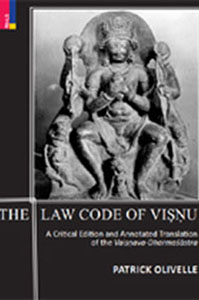
The Law Code of Visnu: A Critical Edition and Annotated Translation of the Vaisnava-Dharmasastra
AUTHOR – Patrick Olivelle
| HB ₹1895 . $89.95 . ₤72.95 |
||
INFORMATION
- AUTHOR : Patrick Olivelle
- HB ISBN : 978-93-86552-87-7
- Year : 2018
- Extent : 604 pp.
- Discount available on checkout
- Usually dispatched within 3 to 5 working days.
Tagore
| HB ₹ 995 . $ . ₤ |
PB ₹ . $ . ₤ |
|
| POD ₹ . $ . ₤ |
e-Book ₹ . $ . ₤ |
INFORMATION
- AUTHOR –
- ISBN – 978-93-84082-78-9
- Year – 2016
- Extent: 400 + 40 coloured illustrations
- 10% discount + free shipping
- Usually dispatched within 3 to 5 working days.
Visnu (Visnu Smrti), Olivelle locates the text geographically in Kashmir and dates it to around the seventh century ce based, among other factors, on the iconographic description of Visnu. Te text was composed by a scholar who belonged to the Kathaka Branch of the Yajur eda and who was also an adherent of the Vaisnava Pancaratra tradition. This is the only legal text that shows a deep influence of the bhakti tradition.
Although the Visnu Smrti did not have as illustrious a life as the treatises of Manu and Yajnavalkya, we find it cited frequently in medieval legal digests. Indeed, unlike citations from other Dharmasastras, medieval authors regularly cite entire sections of this treatise, indicating that they were familiar with a text more or less identical to the one that has come down to us. Consisting of 100 chapters, the text is framed as a conversation between Goddess Earth and Visnu, with Earth requesting the dharma that should govern the lives of those belonging to the four varnas. Originally published in the Harvard Oriental Series, this Indian edition will hopefully make this important text available to a wider Indian audience of scholars and students.
The Editor
Patrick Olivelle is Professor Emeritus of Sanskrit in the Department of Asian Studies at the University of Texas at Austin, and past President of the American Oriental Society
As a global figure, Tagore transcends the boundaries of language and reaches out to people distant both in time and space. His art took inspiration from contemporary Western trends and became a powerful means to connect with people beyond Bengal. Word, image, song, and text were his tools of communication, as also his extraordinary presence in a sartorial garb of his own design. A littérateur in many genres, the impact of his work was determined both by the material he presented, and by its simultaneously local and global contexts. Now, when his international reputation has spanned over more than a hundred years, it is important to revisit the sites of Tagore’s eminence, and ask to what extent he was a ‘living text’ in the century that witnessed him as a global intellectual.
Accordingly, this volume investigates how Tagore’s writings and art are linked to the metalinguistic domains of the psychological, medical and mythical; how he was received in various cultures outside India; how his art was determined by individual circumstances and global aspirations; and how he acted as an inspiration to his contemporaries and subsequent generations including modern Indian writers and artists.
The Editor
Imre Bangha studied in Budapest and Santiniketan and at present is Associate Professor of Hindi at the University of Oxford. He has published books and essays in English, Hindi, and Hungarian on literature in Brajbhasha and other forms of old Hindi and has also prepared Hungarian translations from various South Asian languages. His work on the international reception of Bengali culture includes Rabindranath Tagore: Hundred Years of Global Reception (2014, co-edited with M. Kämpchen) and Hungry Tiger: Encounter between India and Central Europe (2007).
Table of Contents
Table of Contents
| Preface | v |
| Abbriviations | ix-x |
| Introduction | 3-38 |
| Translation | |
|---|---|
| Editor’s Outline | 41-164 |
| Notes on the Translation | 165-195 |
| Critical Edition | |
| Introduction to the Critical Edition | 197-488 |
| Appendices | 491-513 |
| Bibliography | 509-513 |
| Dharmasastric Parallels | 515-528 |
| Sutra Index | 529-569 |
| Index to the Translation | 575-593 |




